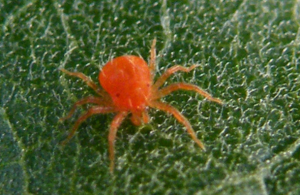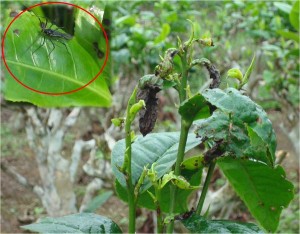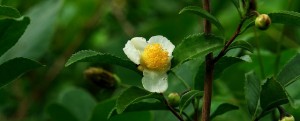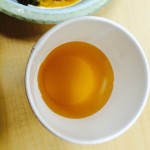Camellia sinensis
Botanical description: Camellia sinensis is more commonly known to populations worldwide as Green Tea. As most of us know by now, these leaves create the most important beverage in the world besides water. It is an evergreen plant that is kept trimmed to 1 meter high, where in the wild it could grow to over 5 meters high. Little yellowish white buds bloom from its branches, where they meet the young, light green leaves that are sought for plucking, and the old, dark green leaves which aren’t so highly desired for tea production and cultivation. The flower buds are 1½ across and have fragrant scents. Leaves are often hairy on the underside.
Native and cultivated geographic ranges: Since tea originated in regions of southeast Asia long ago, it has expanded to adapt in more than 52 countries. There are many different legends told on the beginnings of tea. One includes an emperor in China who accidentally drinks boiling water that had tea leaves fallen in it around the year 2737 B.C. From 600-900 A.D., tea prospered throughout the Tang dynasty as trade caravans carried it to India, Turkey, and Russia. A buddhist monk, for example, brought tea seeds to Japan from China around 800 A.D. In 1657, tea was brought to England by The East India Company. By the early 1700s, tea drinkers were seen across the American colonies.
Suitable climate:
Though the tea plant is a very adaptable species and can grow amongst a diverse set of climate conditions, these various changes in temperature, humidity, and geography, influence the flavor that the tea emanates.
Seasonal climate changes have been thought of as prime cultivating conditions for rich tea flavor that is well-liked. A wet-dry alternation or a double, “bimodal” wet-dry alternation of seasons in a subtropical space is characteristic of most of the popular and high-quality tea producing regions of the world. Tea plants can survive through frosts and winter seasons, however these tea leaves are not considered of high quality. Humidity and rainfall during the growing season are important for Camellia sinensis to thrive.
Altitude also affects the range of quality for a tea. High altitude crops are thought to be more desirable and can sell for astronomical prices. However, altitudes at too great of heights may present temperatures that the tea plants cannot withstand. Closer to the equator, quality teas can thrive at higher altitudes, but the farther from earth’s middle, the high mountainous ranges are not as desirable.
Another interesting phenomenon that contributes to growing tea is that water holds heat. Therefore, South Carolina and Washington State, states initially thought to be too cold to grow tea, are humid enough to retain heat in the moisture in the air.
Suitable soil properties:
The versatility that tea has exhibited in growing across many conditions is similar for its preference of soil too–quite broad. Regions of Darjeeling, Sri lanka and Tanzania, produce good soil for tea because of the archaic rock that forms old, sedentary soil. Zimbabwe and Japan also produce good soil for tea because of the formation of granite in the soil. Indonesia and Kenya provide soils based off of volcanic rocks.
Soil considered good for growing tea is generally found on higher elevated lands. The soil should be well drained and have a good depth. The acidic pH ranges from 4.5-5.5 in prosperous soils, with more than 2% rich in organic matter. Soils that are compacted and shallow limit root growing capability.
Because of erosion and leaching, most tea soils are only moderately prosperous. Phosphorous content is usually low because it’s drained out, and nitrogen content is unpredictable. Clay and gravel should not be present to allow for maximum root penetration. These qualities can usually be found in tropical or subtropical areas and can be indicated easily by a red, earthy color tone.
Major pests and diseases:
Pests and diseases of the Camellia sinensis can first be distinguished by where they attack the plant. Mites and aphids are pests to the buds of tea plants. In the mature foliage of the bushy part, tortixes and mites, again, prey on the plant as food. Borers attack branches, and termites and grubs attack the trunk and base region of the plant. Sucking pests include the tea green leafhopper (Emposca flavescens), the tea aphid (Toxoptera auranti), and the tea mosquito bug (Helopeltis theivora).
The tea mosquito bug is particularly damaging to the plant at the nymph and adult stages. They are known to suck sap from various parts of the plant including the leaves, buds and more tender stems. The leaves will show many dry parts due to this feeding and because of the injection of the bugs toxic saliv a upon sucking. Infected parts by the pest are collected and destroyed. Prevention is seen by spraying with a pesticide known as dimethoate.
a upon sucking. Infected parts by the pest are collected and destroyed. Prevention is seen by spraying with a pesticide known as dimethoate.
Leaf hoppers incur similar damage by sucking the sap from the leaves. They make their home on the plant by first laying their eggs in the tissue of new tea buds. Brownish and yellow discoloration can be seen on the leaves of damaged plants, and may even develop a purplish color. Shading the trees may prevent leaf hopper invasions, as well as mulching to increase humidity and spraying with the pesticide Verticillium.
Propagation methods:
Tea plants have been propagated by four major methods–seed, layering, cutting, and grafting. Seed-bearing reproduction is done just how it sounds, by spreading and planting tea plant seeds, and aiding the various phenotypic expressions to grow to adulthood. Seed planting can have distinct results with variations in shoot heights, leaf and plant shapes, growing periods, and essentially the quality of the tea.
Layering is a method that is more rarely used because of its efficiency, however it is still done in some places. This is done by selecting first a high quality mother plant. This plant’s stems are bent towards the ground and buried in soil, resulting in shoots from a new plant. The drawback of this method is that it can’t be done indefinitely and the mother plant needs sufficient time to recover between layerings. Layering has been most often replaced by the cutting method. This includes cutting stems from a mother plant to create seedlings. It’s seen as a better method because a mother plant can be cut 50 times rather than 10 before the reproduction method loses its viability.
Grafting is the final method of propagation for tea plants that has evolved. Grafting involves joining a tea plant with strong growth to a tea plant with weak growth but better quality. The idea is that the method will invigorate growth and enhance production.
Typical cultivation and harvest practices for field grown plants:
Cultivation and harvesting practices for tea are done with great attention to detail. First, one of the most important aspects about tea cultivation is in the locale that the tea is planted as described in the climate and soil sections above.
Soil is then prepared by a farmer turning and weeding it to allow for root penetrations through a soft soil. Plots are arranged across a plantation in order to uniformly organize the seeds. Between 3 and 5 seeds are sown into ditches and buried with soil. Farmers then water the soil twice a day until germination is evident, then they water once.
A tea plant typically grows for about 3 years until it reaches a mature stage to be plucked and harvested. Terminal buds and new leaves are plucked at this age, and the ages it yields the best leaves are between 5 and 7 years old. Farmers gently pluck the tea leaves at dawn before the dew is gone. Freshly picked leaves must be taken to the processing factory immediately before unwanted oxidation processes begin acting on the leaves prematurely.
Tea plants can survive for many years if they are properly cared for. Every plucking season ends with care for the plants to revive them for the next year. Farmers will prune the plants which does reduce the quality of the tea leaf. When this happens, the entire plant is chopped off from the roots, so that new branches can grow from the base on up.
Bibliography
“Botanical Information,Plant Description Of Camellia Sinensis.” Botanical Information,Plant Description Of Camellia Sinensis. N.p., n.d. Web. 07 Feb. 2016.
“Climate, Geography, and Tea Production.” Climate, Geography, and Tea Production. N.p., n.d. Web. 07 Feb. 2016.
“Evolution of Tea Propagation Techniques–Exhibition of Agricultural Science and Technology.” Evolution of Tea Propagation Techniques–Exhibition of Agricultural Science and Technology. N.p., n.d. Web. 07 Feb. 2016.
“How to Cultivate Tea.” How to Cultivate Tea. N.p., n.d. Web. 07 Feb. 2016.
Muraleedharan, N., and Z. M. Chen. “Pests and diseases of tea and their management.” Journal of Plantation Crops 25 (1997): 15-43.
“The Wide Variety of Soil Types and Their Different Nutrient Properties.” Ideal Soil Nutrient Properties for Tea. N.p., n.d. Web. 07 Feb. 2016.
Figure 1- Camellia sinensis closeup: http://static1.squarespace.com/static/52b757afe4b0a05e7c058354/t/545930f6e4b045b2d208a13e/1415131383572/
Figure 2- Tea plantation workers bringing plucked leaves to factory in India: http://www.huffingtonpost.in/2015/05/04/climate-change-assam_n_7210080.html
Figure 3- A tea mosquito: https://pbs.twimg.com/media/CGmBi6SWoAAKtTw.jpg
Figure 4- A red spider mite: http://pestcontrolathome.com/wp-content/uploads/2015/10/Get-Rid-of-Spider-Mites.png






Leave a Reply